E-commerce and China are almost inseparable. With all their innovation and lucrative profit margins, Chinese products have dominated the world.
That’s why online sellers find it convenient to source products from Chinese wholesale websites like Alibaba and Made-in-China. At the same time, e-tailers have a fundamental question to worry about: is Made-in-China legit and reliable?
In this article, you’ll learn everything about the Made-in-China website to help you decide whether you can trust this for your product sourcing.
Let’s start.
What Is Made-in-China.com?
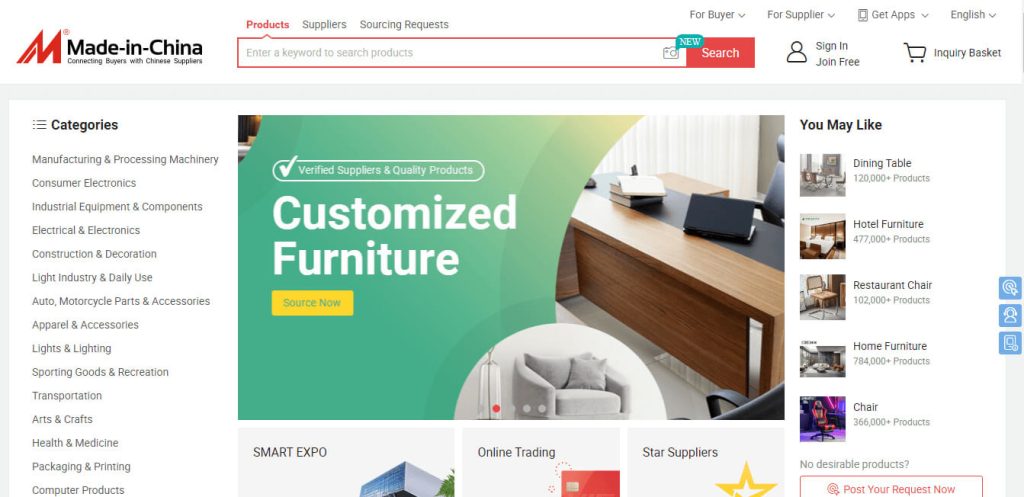
Made-in-China is an e-commerce website that connects and ensures smooth online transactions between international buyers and Chinese suppliers. It began in 1998 and has been working on a B2B model to provide products made in China at certain MOQs.
It has headquarters in Jiangsu, China and two registered offices in the USA.
With over 40 million products from over 3600 categories and 27 sectors, it serves as one of China’s leading directories of products and suppliers.
The platform claims to have over 6 million suppliers and over 14 million registered buyers.
Designed for global trade, Made-in-China.com supports transactions in 11 languages, including English, to facilitate seamless communication between buyers and suppliers.
Many online retailers and businesses use the platform to source products at wholesale prices, resell them, and achieve competitive profit margins.
Is Made-in-China Legit?
Yes! Made-in-China.com is a legit B2B marketplace that’s been around since 1998, connecting global buyers with Chinese suppliers.
It’s owned by Focus Technology Co., Ltd., a publicly listed company on the Shenzhen Stock Exchange, which speaks volumes about its credibility.
The platform is legally registered with headquarters in Jiangsu, China, plus two offices in the USA. A company with such a long history and international presence can’t afford to run shady operations—it would risk everything.
That said, while the platform itself is trustworthy, not every supplier on it is! This is where things get tricky.
The good news is that Made-in-China.com has strict verification measures to help you separate legit manufacturers from questionable sellers.
How Do We Know It’s Legit?
Made-in-China.com isn’t some random website—it’s been in business for over 25 years, which is a lifetime in the eCommerce world. Here’s why that matters:
- It operates under Chinese business regulations and international trade compliance laws.
- Suppliers go through business license verification before they can list products.
- The platform partners with third-party auditors like SGS, Bureau Veritas, and TÜV Rheinland to check if suppliers are the real deal.
So yes, the site itself is 100% legit. But just like Alibaba or any other marketplace, you still need to be careful about who you’re buying from.
How Made-in-China Verifies Suppliers
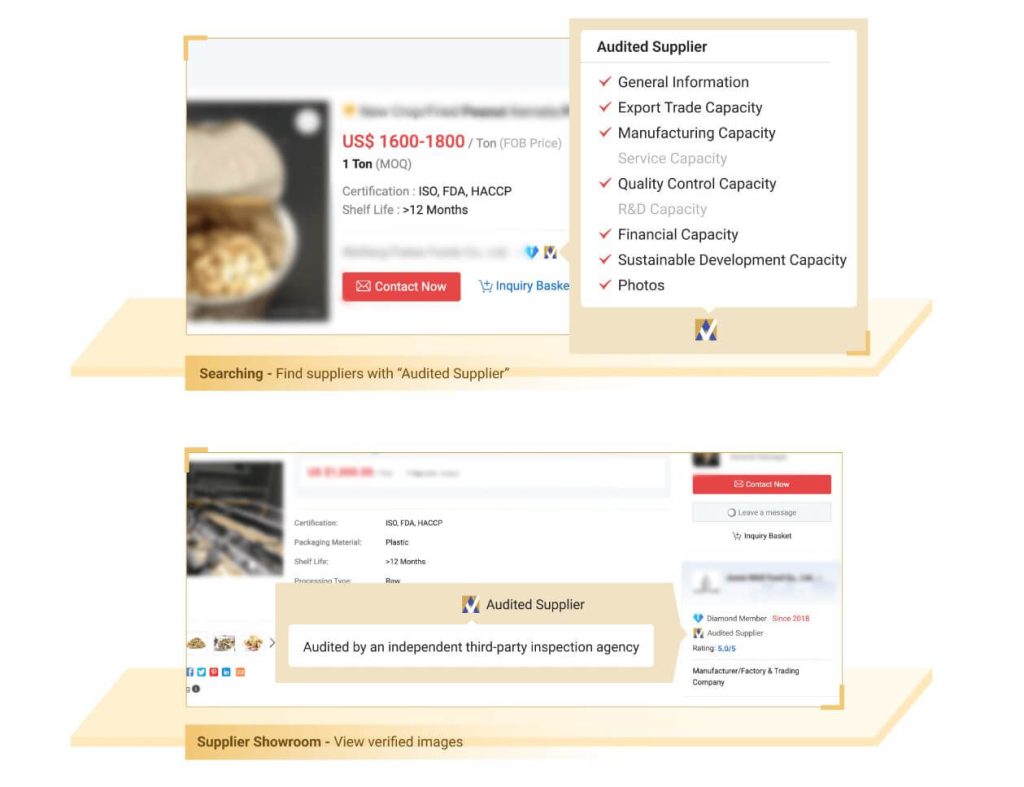
Made-in-China.com has a multi-tier verification system to help buyers assess supplier credibility. The key verification steps include:
- Business License Checks – Suppliers must submit their official business registration documents.
- On-Site Audits – Verified third-party auditors assess the supplier’s manufacturing capabilities, facilities, and compliance with industry standards.
- Supplier Verification Badges – Suppliers that pass specific verification levels receive badges like “Audited Supplier,” “Verified Supplier,” or “Certified Manufacturer.”
Despite these measures, not all suppliers undergo full verification. Some may only be basic registered users, making independent vetting crucial.
Real vs. Fake Suppliers: How to Tell the Difference
Legitimate Suppliers:
- Have detailed company profiles with verified badges.
- Provide clear business licenses and third-party audit reports.
- Offer factory visit options and share real production images/videos.
Potentially Fake Suppliers:
- Lack verification badges or provide inconsistent business details.
- Offer unrealistically low prices without clear explanations.
- Hesitate to provide samples or avoid detailed product discussions.
In short, the platform itself is safe, but doing your homework on suppliers is key to avoiding bad deals.
How Does Made-in-China.com Work?
Made-in-China provides an online platform where buyers can look for the required products and contact suppliers to crack the deal.
There are two ways a buyer can find a product. Either he can search for products or suppliers from its directories or post an inquiry on this platform where the relevant suppliers will contact that buyer with their proposal.
You have the following three search options on the homepage of this website.
- Products
- Suppliers
- Sourcing requests
Let’s discuss each option briefly.
Product Search
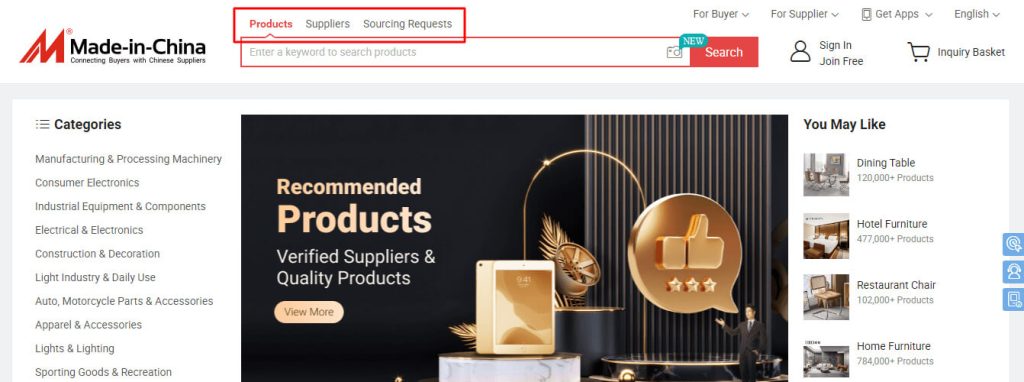
You will have a lot of options in search results with brief product details to give you an overview.
You will notice that the prices are given in ranges. That means the price per product may increase or decrease depending on the ordered quantity.
As it is a wholesale website, the MOQs are also mentioned with the products.
When you click on a product, you will see a detailed product description in most cases along with HS code, packaging type, and other product details like production capacity, etc.
To give you a live feeler about the products, many sellers provide 360 virtual tours so you can check them from every angle.
In some cases, you can also request product customization. So it also allows you to run a private label business.
The products in search results also mention brief details about the suppliers. You can contact them regarding the products and chat to discuss more.
Note: Just like its main competitors like Alibaba, you can also search for a product by uploading its image.
Suppliers Search
Made-in-China has a mix of suppliers, including wholesalers, manufacturers, and direct factories.
Just like the products, you can also search for the suppliers on Made-in-China. You just have to write the product in the search bar and click on the “suppliers” option.
The smart algorithm of Made-in-China displays all the suppliers offering those products.
You will have the following details about suppliers.
- Member type
- Business type
- Main products
- City/province
The specific signs with the suppliers show that they are classified as per their membership in Made-in-China.
You will see certain badges alongside the suppliers on Made-in-China. They are listed below.
- Suppliers with verified business licenses
- Audited supplier
- Free trade security from payment to delivery
Sourcing Requests
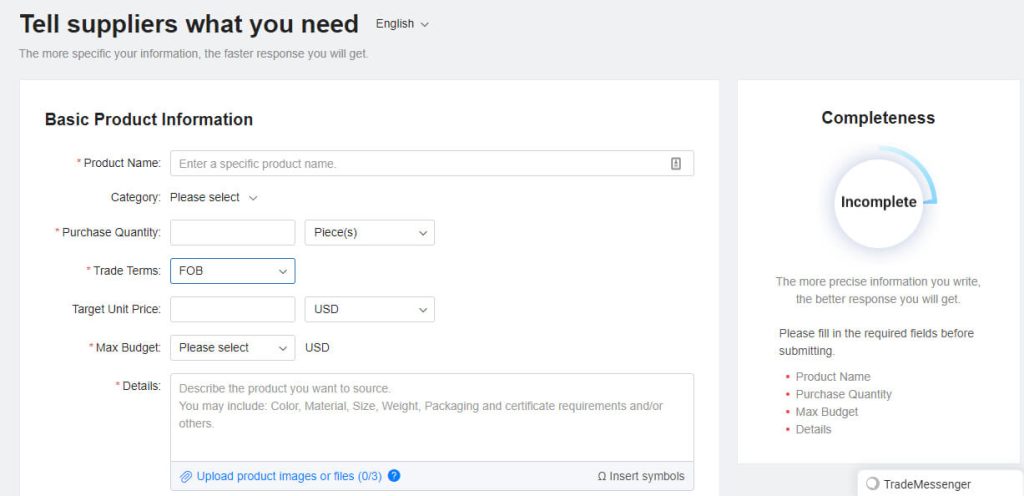
You can also use the “Sourcing Requests” feature to find out the previously posted sourcing requests by other buyers regarding your products.
The information includes the date posted for the quote request, product categories, and purchase quantity or maximum budget.
Ordering
Once a buyer agrees to buy the products from the supplier, he places the order by sharing the delivery address and other details. After depositing the payment, the supplier arranges for the products to deliver to the required address.
Made-in-China closely monitors the whole buying and selling process to ensure transparency and customer satisfaction.
Audited Supplier Program: What It Means for Buyers
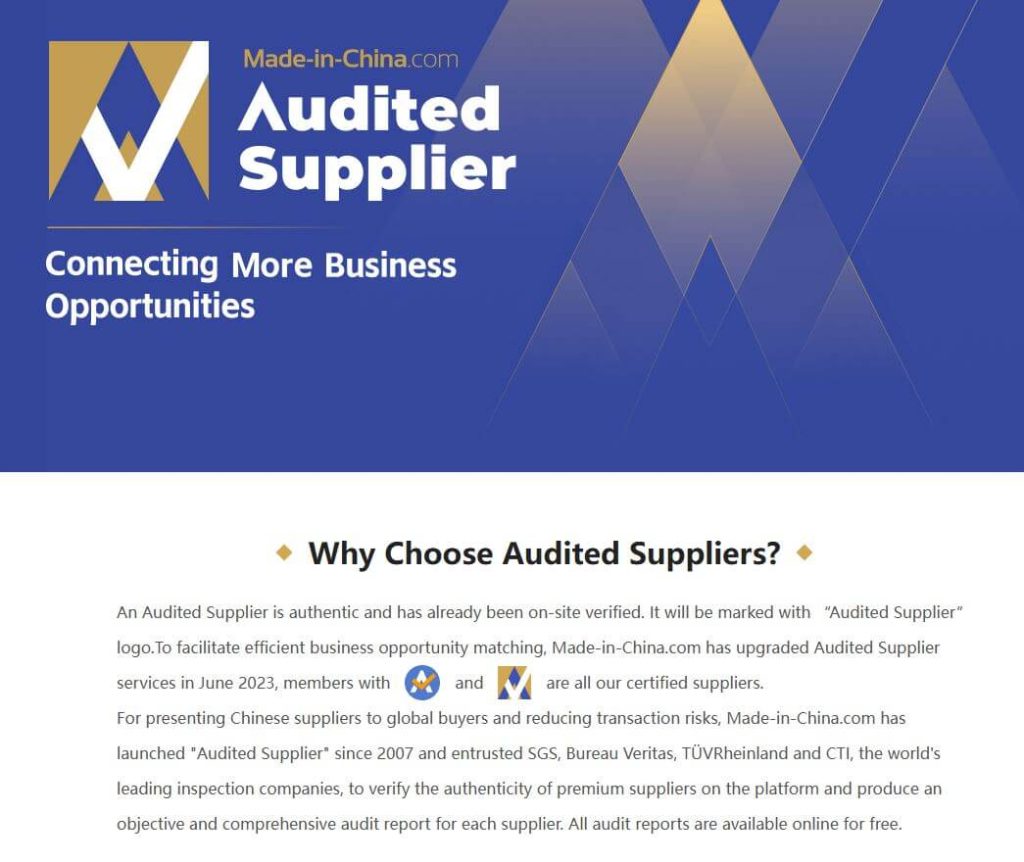
One of the biggest concerns when sourcing from Made-in-China.com is figuring out which suppliers are actually legitimate. That’s where the Audited Supplier Program comes in.
This program is designed to help buyers quickly identify trustworthy suppliers by verifying their business operations, production capabilities, and overall legitimacy.
Instead of just taking a supplier’s word for it, third-party auditing companies like SGS, Bureau Veritas, and TÜV Rheinland conduct on-site inspections.
If a supplier successfully passes the audit, they receive verification badges, making it easier for buyers to separate reliable manufacturers from questionable sellers.
What Is the Audited Supplier Program?
The Audited Supplier Program acts as an extra layer of security for buyers. Made-in-China.com requires suppliers to go through third-party verification to prove they’re legitimate businesses, not just middlemen or traders with no real production capabilities.
The verification process includes:
- Business License Check – Confirms that the supplier is a legally registered company.
- Factory Audit – Inspectors visit the factory to verify production capabilities and product quality.
- Real Photos & Videos – Auditors collect actual images and videos of the supplier’s operations.
- Certification Review – Ensures suppliers hold valid industry-related certifications.
Once approved, suppliers receive a badge displayed on their profile, showing that they have passed the audit.
Types of Supplier Verification Badges
Made-in-China.com uses different badges to indicate how thoroughly a supplier has been verified. Here’s what they mean:
- Gold Supplier Badge – Basic membership; does not indicate any verification.
- Verified Supplier Badge – Confirms that the supplier’s business license has been checked, but no factory audit has been conducted.
- Audited Supplier Badge – Indicates that a third-party inspector has physically visited the supplier’s facility and confirmed their business operations.
The Audited Supplier Badge is the most reliable, as it proves that the supplier has undergone an on-site inspection.
How to Identify Verified Suppliers on the Platform
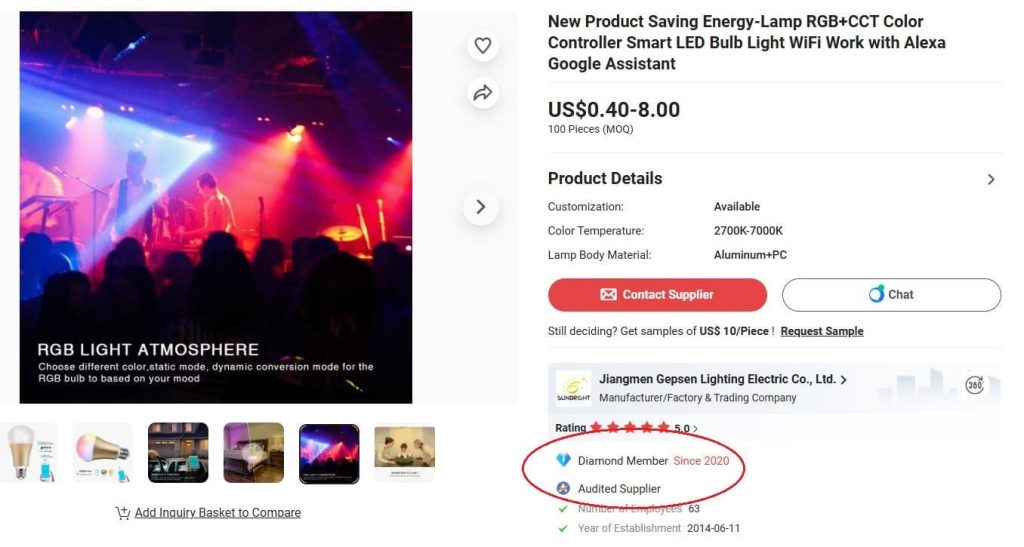
When browsing suppliers, don’t just look at product listings, check their company profile and badges. Here’s how to spot a verified supplier:
- Look for the Audited Supplier Badge – This confirms the supplier has passed third-party verification.
- Read the Audit Report – Some suppliers provide downloadable audit reports on their profile.
- Check for Factory Videos and Photos – Verified suppliers often upload real footage of their production site.
- Compare Contact Details – Legitimate suppliers will have a real factory address, not just a vague location.
If a supplier does not have any badges or verification, proceed with caution. Always request additional details before making a purchase.
Shipping Policy of Made-in-China.com
Made-in-China delivers products to every part of the world. That’s why it is convenient for e-tailers to buy anything from this platform and get the products delivered to their desired destination address.
International shipping is determined by Incoterms. Made-in-China largely works on FOB shipping terms.
It means that Made-in-China suppliers are responsible for delivering the products from their warehouses to the vessel or ship. After that, the goods are the responsibility of the buyer.
The shipping is provided by the following two methods on Made-in-China.
1. Made-in-China Shipping Fulfillment
In this method, Made-in-China provides shipping facilities to the buyer. Currently, Made-in-China is in contract with UPS and 4PX for delivering its products across borders.
UPS may take up to 10 business days, and 4PX may take up to 14 business days for the products to be delivered from China to the USA. The delivery times vary according to the final destination.
2. Supplier-fulfilled Shipments
The suppliers can also arrange the shipping. You can agree on shipping terms with a supplier when you contact him and discuss your preferences.
If a supplier doesn’t offer international shipping, Made-in-China doesn’t take any guarantee of the shipping procedures.
You can share your requirements with Made-in-China, and they will inform you about the shipping details for your required products.
You agree to the shipping contract with suppliers, make the payment, and wait for your products.
Most shipping types provide tracking services.
Shipping Disputes
Made-in-China suggests waiting for the products for up to 60 business days before opening up a dispute. It also adds 15 more days as an additional margin to receive your products.
After that, you can launch a complaint against the supplier, and they will do whatever they can to resolve your issue.
Payment Options of Made-in-China.com
Made-in-China ensures the safety of its customers’ payments. It has an escrow system that keeps the payments on hold for the suppliers until you give a green signal to them.
In case of late or no delivery, the suppliers cannot afford to lose their product without getting any payment. Hence, the suppliers at Made-in-China act professionally.
Made-in-China accepts payments in USD only. International buyers can use the following two payment methods to purchase products from Made-in-China.
1. Credit/Debit Card
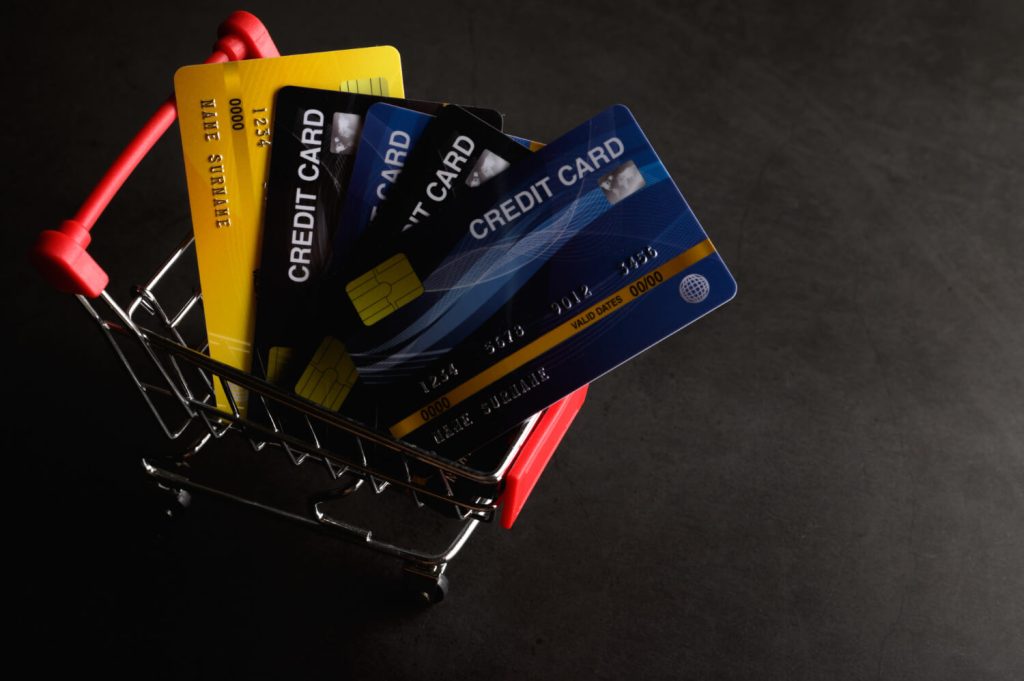
You can make payments using the following types of credit or debit cards.
- Visa
- MasterCard
- JCB
- Diners Club
- American Express
It is the quickest payment method in Made-in-China. You can transfer funds successfully within two hours, but you can’t send more than USD 5,000.
2. Bank Transfer (T/T)
Another payment method on Made-in-China is through bank transfer. Although there is no limit to the amount on bank transfer, it has a drawback too.
It is a lengthy process. It can take up to 2-7 business days till your suppliers receive funds in their accounts.
Return & Refund Rules of Made-in-China.com
Made-in-China provides returns and refund policies on its website to secure your payments.
The following two cases are eligible for returns and refunds on Made-in-China.
1. Defective Products
If you receive products with defects (broken or damaged) or a different product that does not match its promised description.
2. Products Not Received
You pay for the products in advance on Made-in-China. So if you don’t get your orders within the promised timeframe, you can raise a refund inquiry.
Ideally, you should be able to track your products throughout their journey. But if you can’t do so, you should follow up with your supplier.
Made-in-China advises you to wait for another 15 business days in case you do not receive your products. After that, you can apply for a refund.
However, Made-in-China does not accommodate a refund claim for the following reasons.
- Delays beyond the seller’s control, such as natural disasters or other social actions, etc.
- Delays caused due to the receiver, such as wrong address or not receiving the product, etc.
Refund Processing Time
Once your refund is approved by Made-in-China, you will get it within 5-10 business days.
Refunds for Customized Products
Made-in-China doesn’t accept refund claims for products specially customized as per your instructions. So you have to be very careful with your private-label products.
You can still negotiate with your supplier and settle the dispute mutually, but Made-in-China doesn’t mediate in the case of customized products.
In all the above-mentioned circumstances, Made-in-China advises you to contact your suppliers directly. In most cases, suppliers cooperate and try to resolve the dispute amicably.
Otherwise, you would have to contact the Online Trading department at Made-in-China. You just have to share the details of your grievance and one of their representatives will reply within one (1)business day.
That’s where Made-in-China mediates between buyers and suppliers. If you have your case on merit, Made-in-China will refund your payment.
Note: Most suppliers would try to offer you other lucrative incentives like reduced prices on other items against the withdrawal of your complaints. It is up to you to decide whether you want to go with the dispute or agree to the supplier’s incentives.
Buyer’s Responsibilities in the Return Process
In case of a return, you must ensure certain steps. You would have to dispatch the items to the seller’s address along with their tracking details and proper documentation, etc. Failing this may result in no refund at all.
Risk Management: How to Source Safely on Made-in-China.com
While Made-in-China.com is a legitimate sourcing platform, not every supplier on the site is trustworthy.
Scammers, low-quality manufacturers, and middlemen posing as factories can still slip through the cracks. That’s why buyer due diligence is important.
To help you avoid costly mistakes, here’s how to spot red flags, verify suppliers beyond Made-in-China’s verification, and protect your business.
1. How to Verify Suppliers Beyond Made-in-China’s Verification
Made-in-China’s Audited Supplier Program is helpful, but you shouldn’t rely on badges alone. Here’s how to conduct your own verification:
- Check Business License & Certifications – Request copies of their business license and any industry-related certifications. Cross-check with government databases if possible.
- Verify Factory Location – Use Google Maps or Baidu Maps to confirm their address matches what’s on their website and business profile.
- Ask for a Video Call – Request a live video tour of their factory to see the production setup in real time.
- Look for Trade History – See if they have transaction records on platforms like Alibaba, Global Sources, or independent company websites.
- Check Customer Reviews & Complaints – Search for feedback outside of Made-in-China.com, such as in sourcing forums or Trustpilot.
2. Red Flags to Watch for When Evaluating Suppliers
Not every supplier on Made-in-China.com is who they claim to be. Here are some warning signs:
- Suspiciously Low Prices – If a supplier is offering products at unrealistically low prices, they might be cutting corners on quality or trying to scam buyers.
- No Verification Badges – Suppliers without any verification could be a red flag, especially if they claim to be manufacturers.
- Inconsistent Business Details – If the company’s name, address, or registration number varies across different platforms, something might be off.
- Pushy Sales Tactics – If a supplier pressures you to make a large order quickly or refuses sample requests, it’s best to walk away.
- Unclear Payment Terms – If they only accept risky payment methods like Western Union or cryptocurrency, avoid them.
3. Sample Questions to Ask Potential Suppliers
Before placing an order, ask your supplier key questions to test their legitimacy and understand their operations. Here are some must-ask questions:
- Are you a manufacturer or a trading company? (Manufacturers have more control over production and pricing.)
- Can you provide photos/videos of your factory and production process?
- What quality control measures do you have in place?
- Can you provide references from past customers?
- What are your lead times and minimum order quantities (MOQs)?
A legitimate supplier will have no problem answering these questions and providing evidence. If they avoid direct answers, consider it a red flag.
4. How to Request Samples Effectively
Requesting samples is an important step before committing to a bulk order. Here’s how to do it properly:
- Order Multiple Samples – Don’t just rely on one sample. Order from different suppliers to compare quality.
- Request Customization – If possible, ask for slight modifications (like logo printing) to confirm they actually manufacture the product.
- Check Packaging & Labeling – Poor packaging can indicate carelessness in handling products.
- Test Functionality & Durability – If the product is electronic or mechanical, test it under different conditions.
- Evaluate Shipping Time – A slow or untracked delivery could hint at supply chain inefficiencies.
5. Tips for Protecting Your Intellectual Property (IP)
If you’re sourcing a custom or private label product, protecting your IP is critical. Here’s how to safeguard your designs and branding:
- Use Non-Disclosure Agreements (NDAs) – Before sharing any designs, get an NDA signed by the supplier.
- Trademark Your Brand in China – China operates on a first-to-file basis, meaning someone else could legally trademark your brand name if you don’t.
- Avoid Sharing Full Product Details Too Soon – Keep certain specifications private until you trust the supplier.
- Work with Multiple Suppliers – Consider splitting production between two suppliers so no single manufacturer has your full product blueprint.
- Monitor Online Marketplaces – Keep an eye on platforms like Alibaba and 1688 to check if your designs get copied.
Made-in-China.com Reviews in the US and European Countries
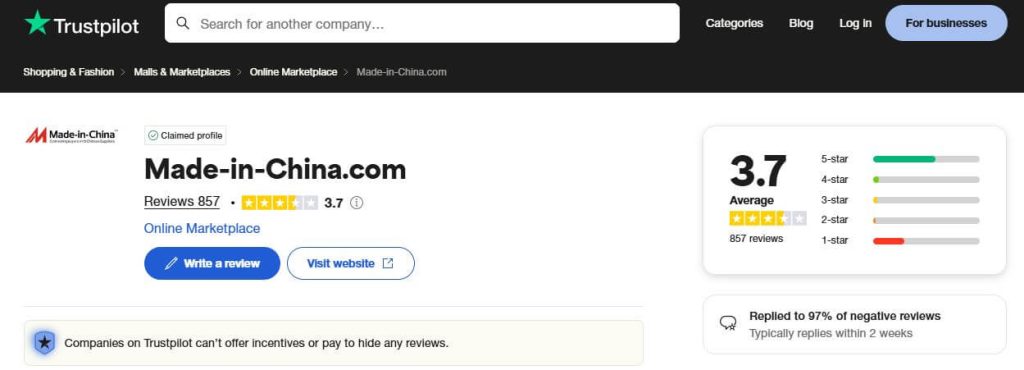
Made-in-China has a mix of reviews from the US and European countries because of the different experiences of the customers.
On Sitejabber, it holds a 3.8 out of 5-star rating based on over 350 reviews. Over on Trustpilot, it also scores 3.8 stars, but with a larger pool of 800+ reviews.

Many buyers appreciate the platform’s wide supplier network and competitive pricing, but some have faced challenges with product quality and communication.
But it’s important to note that Made-in-China is an eCommerce marketplace and not a direct seller.
Success on the platform largely depends on how well buyers vet suppliers, negotiate terms, and request samples before placing bulk orders.
A little extra effort upfront can save you from a lot of headaches later!
Tips to Buy Safely from Made-in-China.com
Following are useful tips that will help you buy safely from Made-in-China.com
Buy from Reputed Suppliers
You should buy from verified suppliers on this platform. You can also apply a sense-check before selecting a supplier. Try looking at the supplier’s profile, factory address, and stock details to name a few.
Use Sourcing Requests
You should consider using the “sourcing requests” option on Made-in-China. It is an automated service from this website that brings the right sellers in contact with you. So, you have the option to choose from the list of recommended suppliers.
You can also email your requests directly to Made-in-China. They will search from their database and will get back to you with the recommended solutions.
Follow Proper Business Procedures
Made-in-China works purely on a business-to-business model. So, you must follow the standard procedure to avoid any unpleasant circumstances.
You must perform the following steps to make your business transaction safe and secure.
- Written and signed contract between you and supplier
- Work with proper invoices
- Make secure transactions through verified banks
- Hire loading inspection services
Use Secured Trading Services (STS)
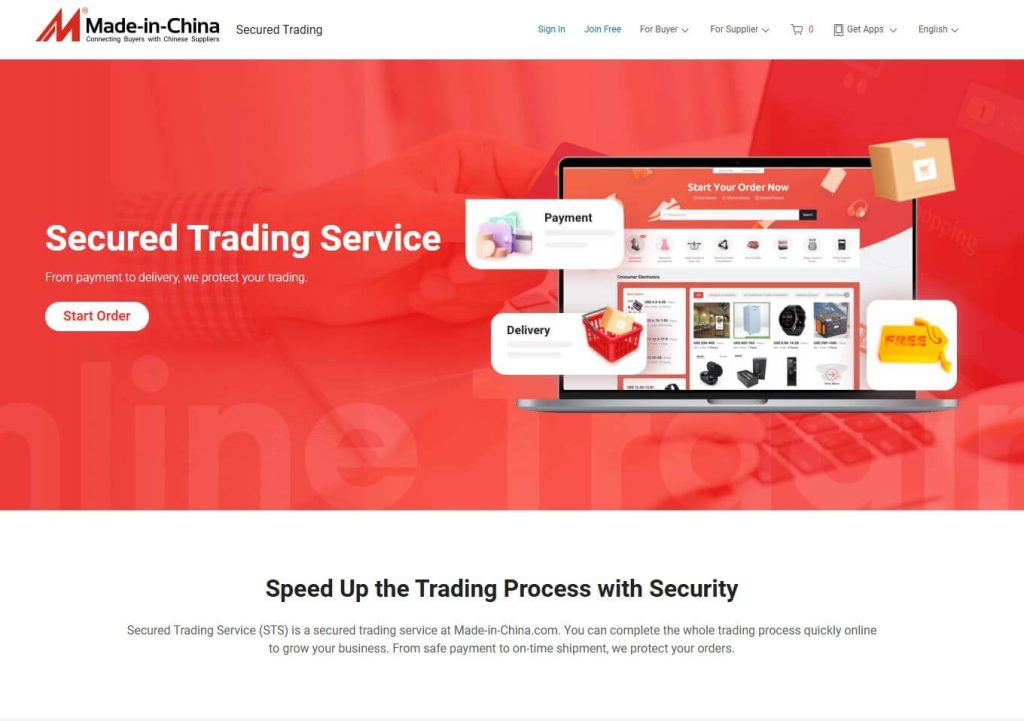
Made-in-China offers its buyers “Secured Trading Services.” In this special service, Made-in-China provides special customer services, secured and monitored payments, easy settlement assistance, etc.
You can use this service just by applying for this service and following the required steps.
Become a Star Buyer
Made-in-China gives an option to all buyers to register as a Star Buyer with very simple prerequisites.
Star Buyer badge will help qualified and premium suppliers to contact you. You can evaluate a supplier with third-party inspection services for your confidence and have the privilege of visiting the supplier’s factory sites.
You will also have “Secured Trading Services” from Made-in-China to minimize your risks.
Hire a Professional Sourcing Agent
A professional and experienced product sourcing agent like NicheSources would be the safest option for you to buy anything from China. That’s because an agent knows how to find quality products at cost-effective prices.
It is also possible that the sourcing company comes with a product solution that even surpasses the offer you got on Made-in-China.
FAQs about Made-in-China
Let’s read the answers to the frequently asked questions to understand if Made in China is legal and reliable.
Does Made-in-China Have Fake Products?
Made-in-China doesn’t have its own products on its website. It is only the platform that connects buyers and suppliers. So, it depends upon the seller if he intends to sell fake products on this website or not.
Can You Get Scammed at Made-in-China?
No. If you keep your transactions under the supervision of Made-in-China, you will not be scammed. But if you make a direct deal with one of its suppliers outside the platform then you will have no protection from this platform.
In that case, it may increase your chances of getting scammed.
What Is the Difference between Alibaba and Made-in-China?
There is no functional difference between Alibaba and Made-in-China. Both are B2B online selling platforms based in China. But both are different companies.
A major difference between them may be the suppliers’ origin. Alibaba has diverse suppliers even outside China while Made-in-China focuses on Chinese suppliers only.
Final Thoughts
Sourcing products from China can open up big opportunities for your business, if you know how to do it right.
Made-in-China.com is a solid platform for connecting with suppliers, but success comes down to choosing the right partners and handling transactions carefully.
And if you’re looking for a more reliable way to source quality products at the best prices then NicheSources is here to help.
Ask for a free quote now, and our representative will be right there to assist you with everything you need.
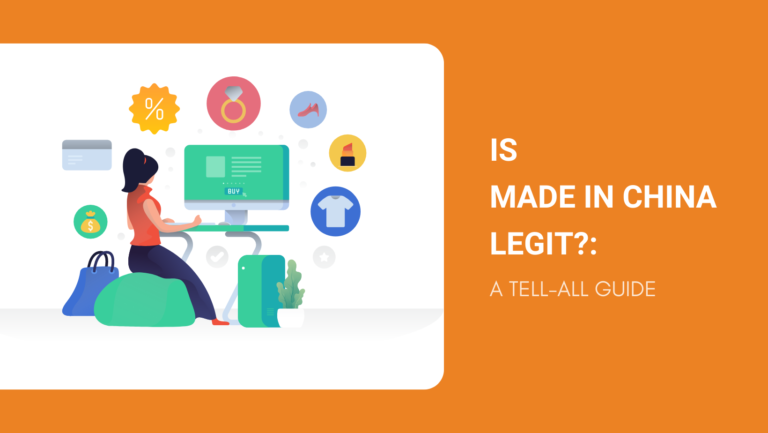

I’ve never tried to buy from overseas I think this is most likely ligit I just don’t like sending the total amount until I have some kind of confrontation of it’s been brought to port I am a business owner I really just want to be safe in my dealings
It is very comforting to see that others are suffering from the same problem as you, wow!